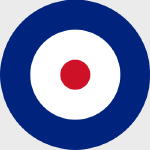Corgi AA28901 RAF Bristol Beaufort Mk.1 Torpedo Bomber - N1016 (OA-X), Pilot Flying Officer Kenneth Campbell, No.22 Squadron, RAF Cornwall, England, 1941 (1:72 Scale)
"Preux et audicieux" ("Valiant and Brave")
- Motto of No.22 Squadron
 The Bristol Beaufort (manufacturer designation Type 152) is a British twin-engined torpedo bomber designed by the Bristol Aeroplane Company, and developed from experience gained designing and building the earlier Blenheim light bomber. At least 1,180 Beauforts were built by Bristol and other British manufacturers.
The Bristol Beaufort (manufacturer designation Type 152) is a British twin-engined torpedo bomber designed by the Bristol Aeroplane Company, and developed from experience gained designing and building the earlier Blenheim light bomber. At least 1,180 Beauforts were built by Bristol and other British manufacturers.
The Australian government's Department of Aircraft Production (DAP) also manufactured variants of the Beaufort. These are often known collectively as the DAP Beaufort. More than 700 Australian-built Beauforts saw service with the Royal Australian Air Force in the South West Pacific theatre, where they were used until the end of the war.
Beauforts first saw service with Royal Air Force Coastal Command and then the Royal Navy Fleet Air Arm from 1940. They were used as torpedo bombers, conventional bombers and mine-layers until 1942, when they were removed from active service and were then used as trainer aircraft until being declared obsolete in 1945. Beauforts also saw considerable action in the Mediterranean; Beaufort squadrons based in Egypt and on Malta helped interdict Axis shipping supplying Rommel's Deutsches Afrikakorps in North Africa.
Although it was designed as a torpedo-bomber, the Beaufort was more often used as a medium day bomber. The Beaufort also flew more hours in training than on operational missions and more were lost through accidents and mechanical failures than were lost to enemy fire. The Beaufort was adapted as a long-range heavy fighter variant called the Beaufighter, which proved to be very successful and many Beaufort units eventually converted to the Beaufighter.
Pictured here is a 1:72 scale RAF Bristol Beaufort Mk.1 torpedo bomber that was flown by Pilot Flying Officer Kenneth Campbell, who was attached to No.22 Squadron, then deployed to RAF Cornwall, England, during 1941.
Sold Out!
Dimensions:
Wingspan: 9-3/4-inches
Length: 7-inches
Release Date: April 2022
Historical Account: "Hunting the Gneisenau" - As an Island nation, the protection of Britain's sea lanes during the Second World War was a crucial battle which had to be won. Throughout the first few months of conflict, the German capital ship Gneisenau and her sister vessel Scharnhorst were posing a serious raiding threat and on receiving news that the ships had entered Brest harbor to undergo repairs in late March 1941, the RAF immediately planned raids intended to destroy, or at least damage the ships. On Sunday April 6th, 1941, Bristol Beaufort Mk.I N1016 (OA-X) took off from RAF St. Eval in Cornwall and headed for a rallying point off the coast of France, close to the entrance to the harbor. Even though the weather was poor, they were surprised to find that they were the only aircraft to make it and with radio silence crucial to the success of the mission, the crew faced the decision whether to press on with their attack alone, or return to base. Although the odds were seriously stacked against them, they turned towards the heavily defended harbor and began their attack run, descending to almost wave top height. Pilot Flying Officer Kenneth Campbell, expertly lined up his Beaufort for the optimum attack angle, passing so close to enemy shore batteries that they could hardly fail to hit their target, but only releasing the single torpedo when he was sure it would strike the warship.
Almost hitting the mast of the ship as the aircraft pulled away in a violent, banking turn, the Beaufort exposed its under surfaces to the anti-aircraft gunners, who raked it with everything they had. Having sustained heavy damage during its attack run against Gneisenau, Bristol Beaufort N1016 crashed into the harbor almost immediately, tragically claiming the lives of all souls on board. Unbeknown to them, their attack had successful and the torpedo had blown a huge hole under the waterline of Gneisenau, causing it to return to the dry dock from where it had only just emerged, in need of further repairs. It would be out of commission for almost six months following the attack and it is impossible to gauge how many lives were saved and how much vital cargo reached its destination as a result of the heroic actions of this single Beaufort crew. Launching their attack alone, the selfless actions of Flying Officer Kenneth Campbell and his crew would have probably gone unheralded had it not been for the intervention of the French resistance. Sending a report on the condition of the German battleship back to British authorities, they also described the actions of this brave Beaufort crew and how they had paid the ultimate price whilst heroically performing their duty. For displaying valor in the face of extreme peril and without regard for his own safety, Flying Officer Kenneth Campbell was posthumously awarded the Victoria Cross, Britain's highest award for valor in the presence of the enemy, an honor he would surely have gladly shared with the rest of his crew.


